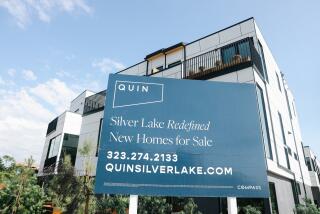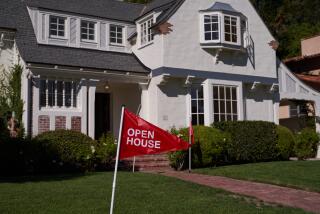New-, Resale-Home Price Gap Growing
- Share via
Do Americans really prefer to buy existing houses over new homes?
National housing statistics indicate that resales of existing houses have been growing steadily in the last 18 months. However, sales of new houses peaked in March, 1986, and have been generally declining since.
Washington realtor Wallace B. Agnew commented that this is generally uncharacteristic of the nation’s housing industry. For many years home-seekers have viewed new and existing houses through the same eyeglasses. Any variations in sales--up, down or steady--affected both in a similar manner.
So what happened last year?
“The gap is partly the result of new homes becoming relatively more expensive,” explained a spokesman for the Federal Home Loan Mortgage Corp. (Freddie Mac).
“The median price of new homes sold in 1986 was 9% higher than in 1985. The prices of existing houses generally rose by only 6% during the same period.” From January to December, 1986, the price gap between new and existing homes widened from $9,500 to $13,800.
That $4,300 differential obviously made most new houses less attractive and certainly less affordable to many home buyers--particularly the first-timers. Longtime national housing savant Edwin L. Stoll pointed out that the price of the nice new house in this booming metropolitan area now has gone above $150,000.
“If you’re already living in a single, detached house that would sell for about $100,000 to $115,000, it’s almost impossible to find a new house that is also bigger and better unless you are willing to pay more than $175,000 and move 10 to 20 miles farther away from the White House,” said recently retired Supreme Court librarian Robert E. Higbie.
Now more couples are looking at existing houses that might need some fixing up. That way they will be able to spend about $140,000 for a fairly large older house with wanted features, and then put about $30,000 into making it what they really want.
Admittedly, according to Stoll and a source at Freddie Mac, some of the widening price gap between new and existing houses reflects additional amenities that new homes have these days. These include cathedral ceilings, skylights, hardwood floors, cedar shake roofs and impressive fireplaces.
Will the divergence continue between prices of existing and new houses?
“There’s always been something of a divergence,” commented realtor Joseph C. Murray. “We bought an existing house three different times since moving into the Washington area more than 30 years ago.
“Each time we would have liked a new house, but price and space were always prime considerations. In effect, we figured to get more bedrooms in a closer-in comparable location if we chose an existing house. And I think that pertains today.”
Robert Libson, an aggressive Washington area builder, contended that move-up buyers prefer the new house if they can afford it and can find what they want in a convenient, attractive new neighborhood.
“New homes have an edge just because they are new and a lot of people like the idea of being the first occupants of a dwelling. It’s a very personal decision,” Libson said.
But recent new-home buyer Henry Handler offered another thought. “My wife and I were attracted by the newness of the house we bought four years ago, but now we have learned about inadequacies of modern, sub-contracted home building. We might look first at existing houses if we were to go house-hunting again this year.”
More to Read
Inside the business of entertainment
The Wide Shot brings you news, analysis and insights on everything from streaming wars to production — and what it all means for the future.
You may occasionally receive promotional content from the Los Angeles Times.










